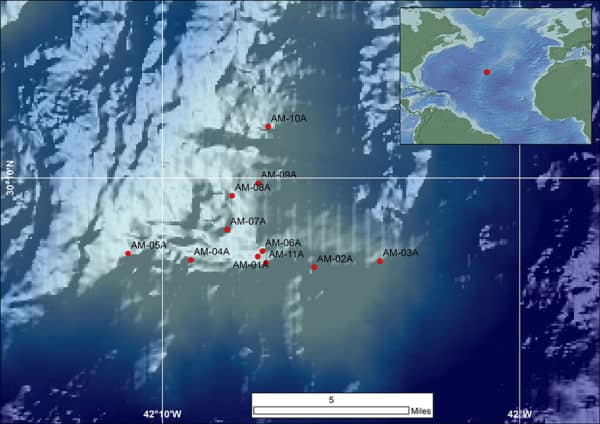
 A more than month long project that collected rock cores from the Atlantis Massif, a 14,000 foot tall underwater mountain along the North Atlantic Ocean, has provided scientists with what they feel are valuable clues into the formation of life on earth and potentially on the other planets.
A more than month long project that collected rock cores from the Atlantis Massif, a 14,000 foot tall underwater mountain along the North Atlantic Ocean, has provided scientists with what they feel are valuable clues into the formation of life on earth and potentially on the other planets.
The ambitious expedition drilled into the earth’s mantle aimed to examine how rocks rise to the sea floor and interact with sea water, a process scientists hope can provide clues as to how life forms in the absence of sunlight. Researchers were surprised to find signs of life.
“The rocks collected on the expedition provide unique records of deep processes that formed the Atlantis Massif,” said Co-Chief Scientist Gretchen Fruh-Green from ETH Zurich in Switzerland. “We will also gain valuable insight into how these rocks react with circulating seawater at the seafloor during a process we call serpentinisation and its consequences for chemical cycles and life.”
Another researcher says the discovery could prove valuable to learning about life on other planets.
“During drilling, we found evidence for hydrogen and methane in our samples, which microbes can ‘eat’ to grow and form new cells,” said Co-Chief Scientist Beth Orcutt from Bigelow Laboratory for Ocean Sciences in US. “Similar rocks and gases are found on other planets, so by studying how life exists in such harsh conditions deep below the seafloor, we inform the search for life elsewhere in the universe.”
The scientists involved in the project are part of International Ocean Discovery Program Expedition 357, which was conducted by the European Consortium for Ocean Research Drilling. The expedition left from Southampton, England on October 26, 2015, on board the Royal Research Vessel James Cook, which is operated by the U.K.-based National Environment Research Council. The researchers returned on December 11, 2015.
During drilling, we found evidence for hydrogen and methane in our samples, which microbes can ‘eat’ to grow and form new cells. Similar rocks and gases are found on other planets, so by studying how life exists in such harsh conditions deep below the seafloor, we inform the search for life elsewhere in the universe.
A team of 31 scientists from 13 different countries, including Canada, Australia, China, France, Germany, Italy, Japan, Korea and Norway are currently examining the results at at the International Ocean Discovery Project at the Bremen Core Repository in Bremen, Germany.
The Earth’s mantle is the layer between the crust of the planet and the outer core. The area is a silicate rocky shell with an average thickness of nearly 30000 kilometres. The other terrestrial planets in our solar system, Venus, Mars and Mercury, have similar mantles. In certain places on earth, the mantle is actually exposed. In other places, including the Tablelands region of Gros Morne National Park in Newfoundland and Labrador, mantle rock has been pushed to the surface by tectonic activity.
This isn’t the first time scientists have drilled into the Earth’s mantle. On May 24, 1970 drilling began on the Kola Superdeep Borehole, which over the course of the next 19 years, drilled more than 12 kilometres into the Pechengsky District in the Soviet Union. Russian scientists found single-celled organisms at a depth of seven kilometres, where the temperature reached 356°F.
Leave a Reply
You must be logged in to post a comment.




 Share
Share Tweet
Tweet Share
Share




Comment